

To
Our Readers
The series of articles, Pre-Jet Air Cargo,
is a condensed history of the opening phase of the infant air cargo
industry’s first generation—a period that is unfamiliar
to most of the current crop of men and women comprising the industry.
The text is based on a broad scope of authoritative sources—highlighting
the more significant events, official actions, technical developments,
and professional comment.
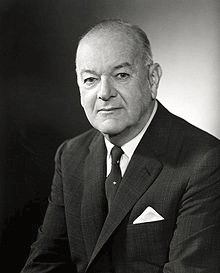 The
post war surge of airlines with war-surplus aircraft was a stirring
symbol of the fast-unfolding Air Cargo Age. Three years later that symbol
ballooned as the coordinated operations of U.S. commercial and USAF
cargoplanes defied Russia’s blockade of Berlin to keep more than
2.5 million inhabitants alive.
The
post war surge of airlines with war-surplus aircraft was a stirring
symbol of the fast-unfolding Air Cargo Age. Three years later that symbol
ballooned as the coordinated operations of U.S. commercial and USAF
cargoplanes defied Russia’s blockade of Berlin to keep more than
2.5 million inhabitants alive.
The Airlift is mentioned here because
of its concurrence with the take-off of the air cargo industry; the
operational exploits at what came to be known as Operation Vittles were
vast and cannot properly be condensed for the purpose of this series.
Trans-atlantic commercial aircraft were steady feeders to Air Force
freighters at Rhein-Main Airport.
Aiming a roundhouse at the freight-only
air carriers, American Airlines Chairman C. R. Smith (left) rejected
the claim of the all-cargo airlines that the uniqueness of air freight
was in effect an industry all its own.
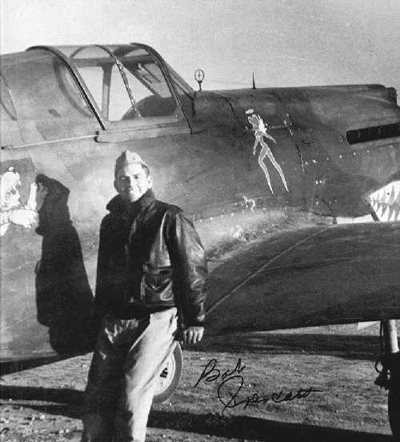 Robert
Prescott, (right) president of the Flying Tiger Line, came roaring back
with the charge that the air freight potential had been lying before
their eyes for long years, but they were sightless to the opportunity.
The realities and lessons of the war suddenly handed them vision, and
they wanted that business all to themselves.
Robert
Prescott, (right) president of the Flying Tiger Line, came roaring back
with the charge that the air freight potential had been lying before
their eyes for long years, but they were sightless to the opportunity.
The realities and lessons of the war suddenly handed them vision, and
they wanted that business all to themselves.
Holding a magnifying glass over the emotional
squabble between supporters and opponents on contract and nonsked cargo
airlines, H. J. De Gel, a transportation consultant, criticized the
established carrier’s claim to prior rights as “selfish.”
Langdon P. Marvin, Jr., who formerly served
as chairman of the Interdepartmental Air Cargo Priorities Committee,
was an ardent supporter of the concept of a Merchant Marine of the Air.
A strong airfreighter fleet that would be useful to the domestic and
international economies as well as a valuable asset in times of conflict.
As an aside, Marvin pointed out that it took 5, 000 pounds of cargo
to support a single soldier.
At Pan Am, Willis G. Lipscomb, vice president
– traffic and sales, made no mention of the proposed Merchant
Marine of the Air, but his words added up to the same objective. The
progress of air cargo could make a substantial contribution to world
economic recovery and national defense. He was inclined to regard IATA’s
cargo sales agent as the “keystone” in the arc of the nation’s
air commerce. It’s a fact that air cargo’s great for the
shipper and consignee, but—and you can’t get away from it—there
is an urgency to go out and sell it.
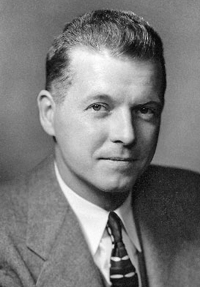 Arthur
V. Norden, (left) however, found that reference to an aerial merchant
marine was close to his own brand of thinking. Norden, executive vice
president of Seaboard and Western Airlines, saw it as having the capacity
to haul in overseas flight with crews adequately trained to deal with
tons, rather than pounds, from loading to offloading. As a bit of added
emphasis, Norden noted that combination aircraft were designed to fly
passengers, mail, and small-parcel express.
Arthur
V. Norden, (left) however, found that reference to an aerial merchant
marine was close to his own brand of thinking. Norden, executive vice
president of Seaboard and Western Airlines, saw it as having the capacity
to haul in overseas flight with crews adequately trained to deal with
tons, rather than pounds, from loading to offloading. As a bit of added
emphasis, Norden noted that combination aircraft were designed to fly
passengers, mail, and small-parcel express.
The results of an air cargo research study
during the war years concluded that development of packaging for air
transport was good; return on investment in publicity, excellent; consumer
education and development of new business and a lively air cargo market
since the war’s end, much to be desired. What course must be taken
now? Suggested J. Prescott Blount, managing director of the Air Cargo
Institute of California: The right way to go is a new, up-to-date air
cargo research project funded by airlines and aircraft manufacturers.
At about this time, four all-cargo nonskeds
won a CAB examiner’s recommendation for certification: Flying
Tiger Line, Slick Airways, California Eastern Airways, Willis Air Service,
U.S. Airlines, and Airnews.
Appalled by the nonexistence of a negotiable
air waybill, A. M. Strong, vice president of the American National Bank
and Trust Company of Chicago, maintained that the lack of such a document
is injurious to U.S. foreign commerce. Delay in righting the situation
was adversely affecting the nation’s air traffic as well as international
trade, he warned. Strong expressed confidence that a negotiable air
waybill can be devised, and which can satisfy existing needs of international
air trade.
Calling the Air Freight Forwarder Case “unique,”
CAB Examiner J. Earl Cox said the Board was required to “determine
whether freight forwarders should be permitted to function as indirect
air carriers and so engage in air transportation, and adopt measures
for regulating the incipient air freight forwarding industry, if authorized.”
 As the story goes, a sales executive at Air
Express International returned directly to the AEI office after a lengthy
transcontinental flight to find a TWX message waiting for him. The communication
was from the company’s agent in Paris, and it was bilingual: “Rien
ne reussit comme ce succes. Good luck.” The word from Paris couldn’t
have taken a more indirect route. It was a cryptic reference to the
CAB’s recognition of the air freight forwarder.
As the story goes, a sales executive at Air
Express International returned directly to the AEI office after a lengthy
transcontinental flight to find a TWX message waiting for him. The communication
was from the company’s agent in Paris, and it was bilingual: “Rien
ne reussit comme ce succes. Good luck.” The word from Paris couldn’t
have taken a more indirect route. It was a cryptic reference to the
CAB’s recognition of the air freight forwarder.
By a majority vote, the CAB granted authority
to air freight forwarders to operate as indirect air carriers for a
period of five years—a temporary stretch of time during which
the forwarders could gain the “essential experience” that
would lead to permanent certification.
But the forwarders’ whoops of joy
and champagne quaffing turned out to be premature. With its scheduled
airlines claiming substantial errors in law, they filed an appeal with
the United States Circuit Court of appeals in Chicago. Result: a stay
of the CAB order.
Given the intensity of the certificated
carriers’ appeal, the air forwarders were not surprised by the
court’s stay, but they were not without loud sounds of frustration.
At Skyways Freight Corporation, Vice President George K. Haney addressed
a plea tobusiness reason. He maintained that the forwarder augmented
the airline’s sales staff. The airlines, he went on to say, should
hold out a hand of welcome to the forwarder because his added freight
volumes produced greaterfreight revenue, every carrier’s No. 1
concern.
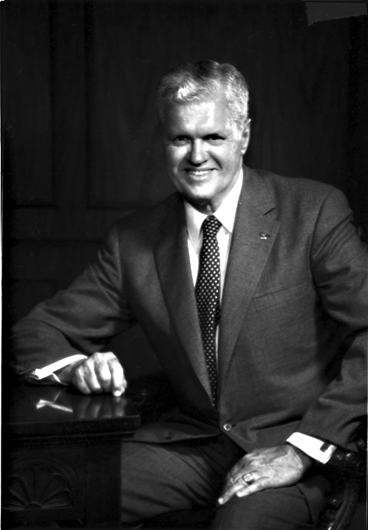 A bit earlier, John C. Emery (right) offered
his personal reasons why the certificated carriers opposed air forwarder
certification: a fear that the forwarders would concentrate on directing
their tonnage to the all-cargo airlines.
A bit earlier, John C. Emery (right) offered
his personal reasons why the certificated carriers opposed air forwarder
certification: a fear that the forwarders would concentrate on directing
their tonnage to the all-cargo airlines.
With a sharp eye cocked on the rate of
air freight progress, Louis W. Goodkind, assistant director (domestic)
of the Civil Aeronautics Board, estimated that commercial air freight
was just about edging out of the experimental stage and moving into
the developmental stage.
Parenthetically, he asserted that the
CAB is charged with the development of a strong and “operationally
safe air transportation system”—well-constructed, dependable
public service; a system adapted to commercial and postal service needs,
and requirements of the national defense.
As part of the President’s Air Policy
Commission’s recommendations for air cargo, it stated: “The
soundest way to build up a pool of cargo planes for an emergency is
to develop a cargoplane that can operate on a profitable basis. We are
recommending the creation of an aircraft development corporation whose
initial and primary task could be the development of an all-cargo transportation
airplane. Such a plane, of course, would have to be useful to the military,
but it should be designed primarily with a view to economic commercial
operation.”
On a triumphant note, the Port Authority
of New York activated the world’s largest and most modern airport—Idlewild
(now JFK)—serving the New York-New Jersey Port District. Six foreign
flag airlines plus Seaboard and Western Airlines prepared to shift operations
to the larger facility, from LaGuardia Airport.
W. R. Rogers, an ex-vice president at
Slick, urged standardization of airport rates because the charges paid
“influences what (the airline) charges the shipper.” Furthermore,
these rates should be “…fixed for a period of time,”
allowing orderly ratemaking.
Scheduled or nonscheduled, certificated
or independent, the airlines were finding the task of stowing cargo
a huge headache because of the lack of an airplane specifically designed
primarily to fly freight. The DC-3 and DC-4, which currently dominated
the airlanes, were designed for the passenger foremost in mind. The
C-82 and C-97, engineered for cargo, were strictly for military operations.
Specialists were hard put to develop better methods of stowing shipments
of unequal size, shape, and weight in tubular-shaped passenger bellies.
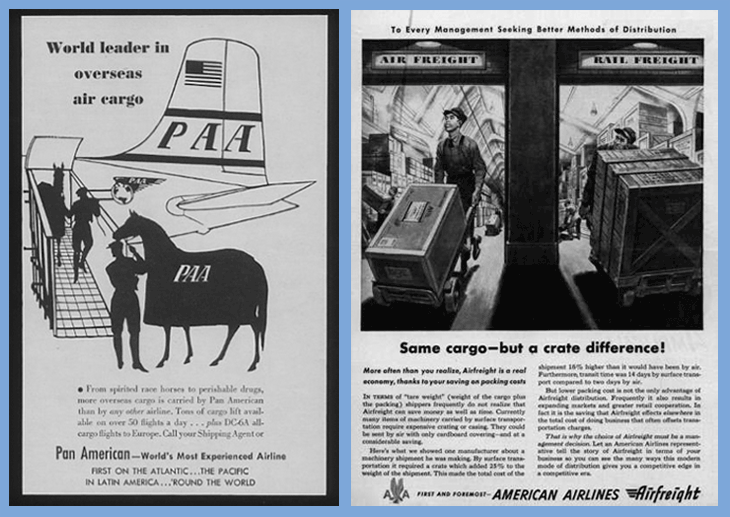 |
Was air cargo born as a result of the
exigencies of World War II? Hardly, said Rear Admiral Lawrence B. Richardson
(Ret.), now a vice president at Curtiss-Wright Corporation. Its roots
as a business date back to late 1919, and nearly a decade later the
development of air express was boosted by the switch of air mail to
the scheduled airlines. However, development of air express business
was feeble, reflecting the carriers’ view that it was but a minor
add-on to its regular passenger and mail traffic business.
With the explosive growth of freight,
Adm. Richardson saw the potential of air freight business as “practically
unlimited.” The ingenuity of man, he predicted, will bring superior
operating equipment, and costs will inevitably slide downward, opening
aerial paths to new markets. Turning to the needs of national defense,
Adm. Richardson stated that 200 adaptable long-range airfreighters will
be available to the military by 1950. He estimated an eventual all-cargo
fleet of 750 aircraft.
J.E. Winchester, sales engineer and coworker
of Adm. Richardson at Curtiss-Wright, declared bluntly that lowered
cargo rates and the airlift of greater varieties of commodities in greater
volume were not possible at the present time. Current equipment was
largely converted war-surplus planes originally designed to carry passengers.
Transporting cargo in such aircraft was like eating peas with a knife,
Winchester said.
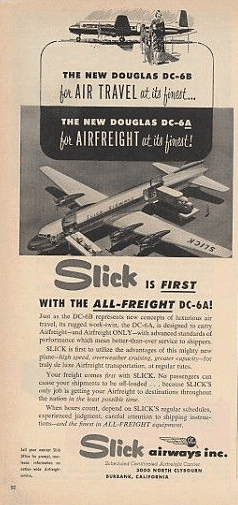
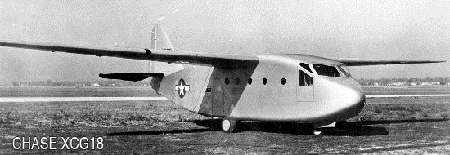
From Douglas Aircraft came word of the C-124, a military
airfreighter two-and-a-half times bigger than the company’s DC-4.
With a maximum load of 15 tons aboard, the plane could fly 1,200 miles
and return. Normal range wass about 5,000 miles. The C-124 was an offshoot
of the 124' 2" long C-74 Globemaster.
Douglas had another message to deliver: it
has decided to build a freighter version of the DC-6. It will have a
capacity of 151/2 tons coast to coast. Direct loading/unloading will
be accomplished by a built-in freightpower lift.
Does the glider fit into air cargo’s
future? Apparently the folks at the Chase Aircraft Corporation thought
so, although commercial operators seemed less inclined to agree. The
manufacturer’s all-metal XCG19A was 24-feet long and had a towing
speed of 210 miles per hour. Its payload was four tons. The glider was
under consideration by the Air Materiel Command.
The newly organized Air Cargo Institute
of California disclosed an ambitious agenda. It will carry out experimental
shipments of agriculturals and manufactured products, from producer
to consumer, with the findings made available to participating companies
and organizations. Included in the Institute’s membership were
major airlines, all-cargo carriers, Pacific Coast manufacturers, packaging
materials and container producers, agricultural products manufacturers,
farmer cooperatives, flower shippers, and representatives of various
chambers of commerce.
Synchronous with the leaping quarterly
air freight totals during the latter half of the Forties were the loud
bursts of enthusiasm emanating from airline cargo departments, leading
to somewhat aggressive prophesizing. As man after man cheerfully predicted
that air freight revenue would come abreast air passenger revenue in
10 or 15 or 20 years, Pan Am remained silent. The word from Pan Am was,
in effect, “no comment.” Then one day as the calendar drew
closer to the Fifties, the carrier’s cargo sales boss, John. W.
G. Ogilvie, not without a prompter’s nudge, declared his belief
that Pan Am’s cargo (including express) will equal passenger revenue
“within a decade.” The passenger department was officially
silent, but there were persistent reports of a profound collective smirk
behind closed doors.
Richard
Malkin
malkin101@aircargonews.com
Click
Here To Read Intro
Click
Here To Read Part I
Click
Here To Read Part II


